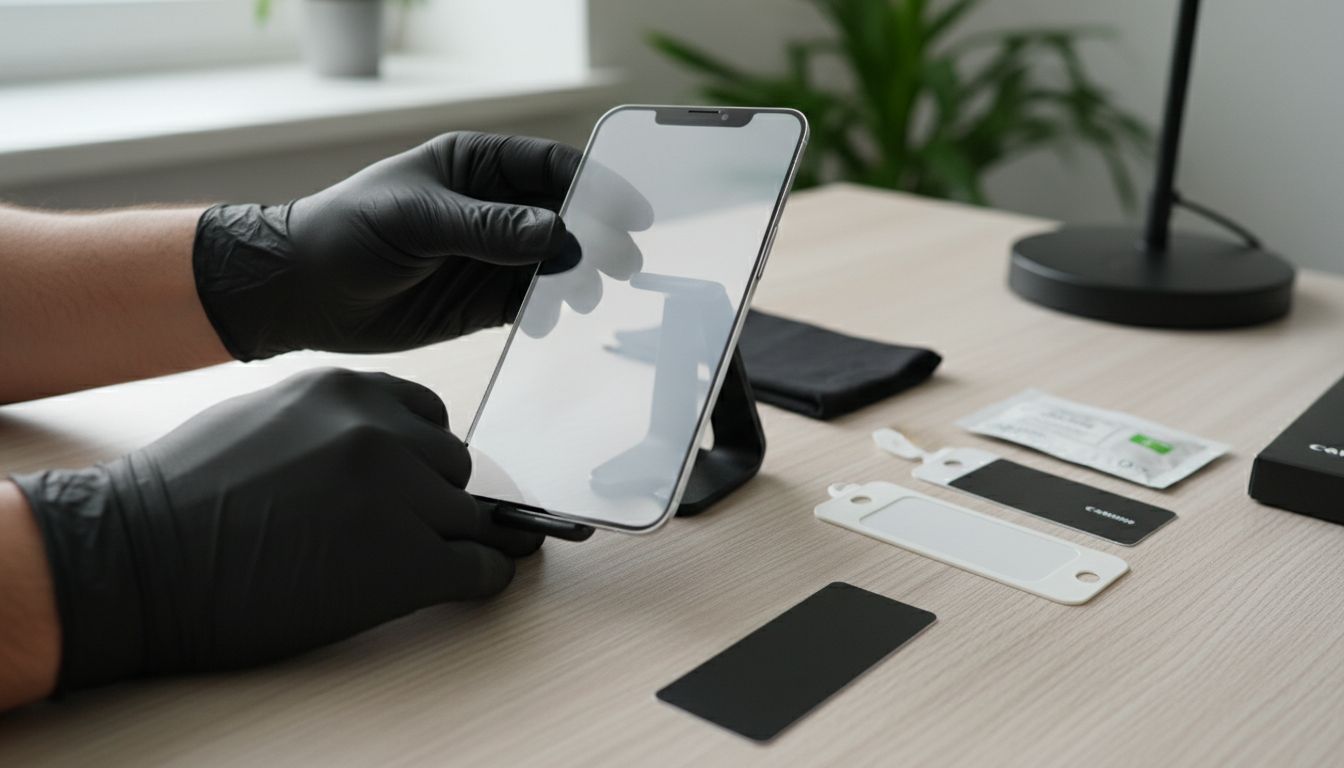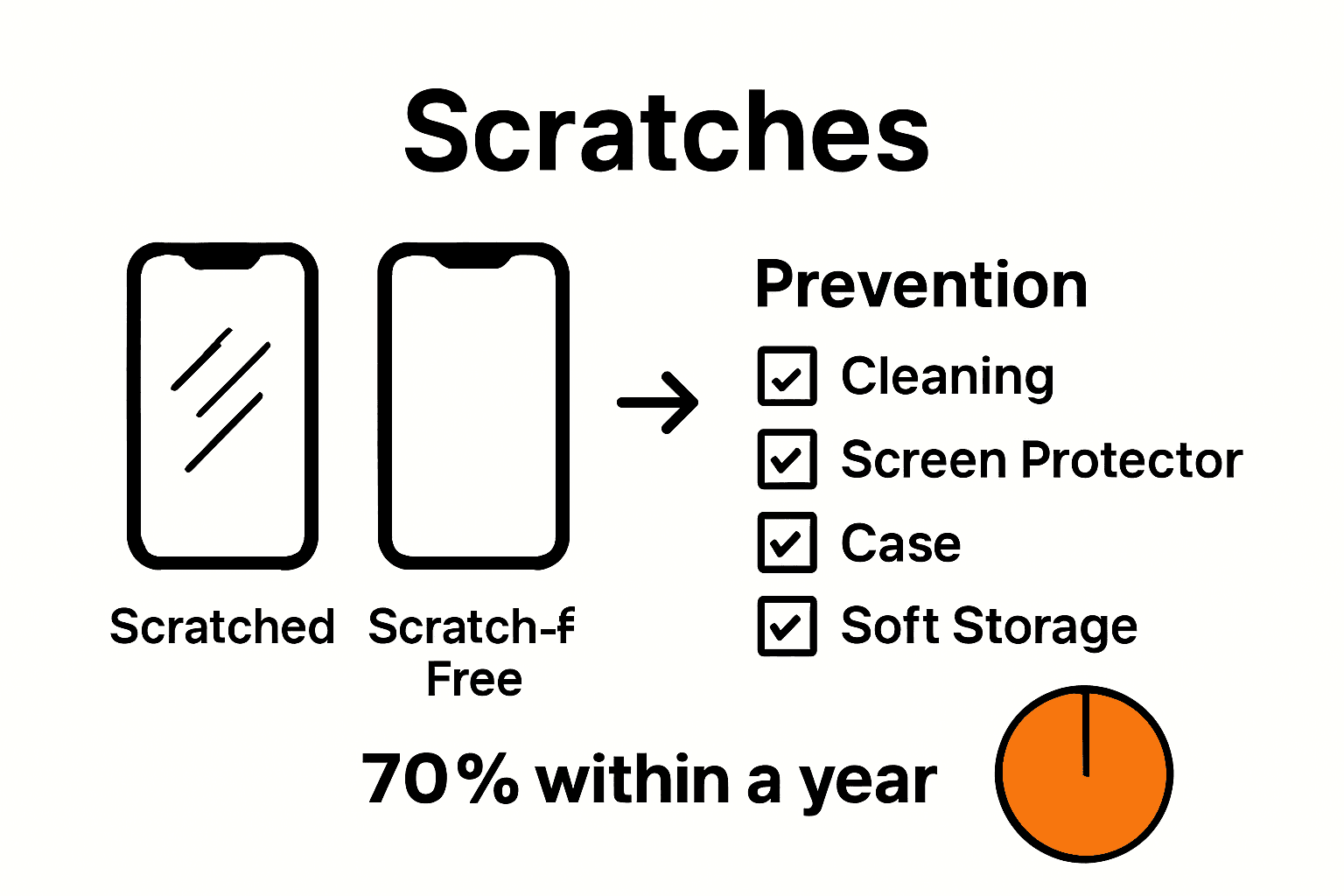
How to Prevent Phone Scratches: Proven Steps for 2025
Share
Nearly 60 percent of smartphone users notice scratches or marks on their device within the first year. Protecting your phone is about more than just looks—it also maintains performance and resale value. When you know the most effective ways to prevent scratches, your device stays safer and cleaner for longer. From simple cleaning steps to smart storage habits, you can keep your phone looking brand new and avoid costly repairs.
Table of Contents
- Step 1: Clean Your Phone and Hands Thoroughly
- Step 2: Apply a High-Quality Screen Protector
- Step 3: Choose and Fit a Durable Phone Case
- Step 4: Use Soft Surfaces and Safe Storage
- Step 5: Check Your Phone for Scratch Risks
Quick Summary
| Key Point | Explanation |
|---|---|
| 1. Thoroughly clean your phone and hands | Regular cleaning helps reduce dirt transfer that can scratch your phone’s screen and body. |
| 2. Apply a high-quality screen protector | A tempered glass protector provides essential defense against scratches and impacts. |
| 3. Choose a durable phone case | A case with raised edges can safeguard your phone from scratches and drops effectively. |
| 4. Use soft surfaces for storage | Placing your phone on soft materials prevents contact with rough surfaces that could cause abrasions. |
| 5. Regularly check for scratch risks | Routine inspections help identify and address any developing scratches before they worsen. |
Step 1: Clean Your Phone and Hands Thoroughly
Preventing phone scratches starts with maintaining impeccable cleanliness. By thoroughly cleaning your phone and hands, you reduce the risk of transferring dirt and grime that could cause micro abrasions on your device screen and body.
According to Ulster University, mobile phones can harbor numerous germs and bacteria, making regular cleaning essential. Start by washing your hands with soap and warm water for at least 20 seconds, ensuring all surfaces are scrubbed clean. After drying your hands completely, prepare to clean your device.
Following guidance from Derbyshire Healthcare NHS Trust, power down your phone before cleaning. Use a soft microfibre cloth slightly dampened with water or a specialized electronics cleaning solution. Gently wipe the screen and phone body, avoiding excess moisture near ports or openings. Never spray liquid directly onto the device. Quick tip: rotate the cloth frequently to prevent spreading dirt and always use a clean section of the cloth for each wipe.
Now you are ready to handle your phone without introducing scratches or additional contaminants.
Step 2: Apply a High-Quality Screen Protector
Protecting your phone screen from scratches requires more than just careful handling. Applying a high-quality screen protector is your first line of defence against daily wear and potential damage.
According to London School of Economics, investing in a tempered glass screen protector provides crucial protection against bumps, drops, and scratches. Begin by thoroughly cleaning your phone screen using the techniques from the previous step. Ensure the surface is completely free of dust, fingerprints, and debris. This preparation is critical for a smooth and bubble-free application.
To apply the screen protector, work in a clean, dust-free environment. Align the protector carefully, starting from one edge of the screen and slowly lowering it at a 45-degree angle. Use the provided alignment stickers or guides to ensure perfect positioning. Derbyshire Healthcare NHS Trust recommends using protective measures like screen protectors to safeguard devices from physical damage. Pro tip: Use a credit card or the included applicator to smooth out any air bubbles, working from the centre outwards. Take your time and be patient the first application can be tricky.
With a perfectly applied screen protector, you have significantly reduced the risk of scratches and potential screen damage.

Step 3: Choose and Fit a Durable Phone Case
Protecting your phone from scratches goes beyond screen protectors. Selecting the right phone case is crucial for comprehensive device protection and preventing potential damage from daily wear and accidental drops.
According to London School of Economics, an ideal phone case should have raised edges around the screen and camera to provide extra protection against potential scratches and impact damage. When choosing a case, consider materials that offer robust protection without adding excessive bulk. Look for options with shock-absorbing properties like silicone, rubber, or hard polycarbonate materials that can cushion your device during accidental drops.
Fitting the case requires patience and precision. Derbyshire Healthcare NHS Trust emphasizes the importance of using protective cases to prevent physical damage. Start by ensuring your phone is clean and free from dust or debris. Carefully align the case, starting with the corners and working your way around the device. Make sure all ports and buttons are perfectly accessible. Pro tip: If your case has a soft inner lining, ensure this touches the phone first to prevent additional scratching. Gently press around the edges to confirm a snug fit.
With a well-chosen and properly fitted case, your phone now has a strong first line of defence against potential scratches and impact damage.
Step 4: Use Soft Surfaces and Safe Storage
Preventing phone scratches requires more than protective gear. How and where you place your phone can make a significant difference in maintaining its pristine condition.
London School of Economics recommends using wrist straps or phone lanyards to minimise accidental drops, especially in crowded environments. When not actively using your device, seek out soft surfaces like fabric covered tables, cushions, or clean folded towels that can prevent hard surface contact and potential scratching. Avoid placing your phone on rough materials like concrete, unfinished wood, or surfaces with embedded particles that could cause micro abrasions.
Derbyshire Healthcare NHS Trust emphasizes storing devices in clean and dry areas to prevent physical damage. Create dedicated storage spaces like padded phone pouches or soft compartments in bags where your device can rest without risk of friction or impact. Pro tip: Consider using a dedicated phone stand or holder when at home or work to minimise unnecessary handling and potential dropping. These small habits can significantly extend your phone’s aesthetic and functional lifespan.
By implementing thoughtful storage practices, you create an additional layer of protection against unexpected scratches and wear.
Step 5: Check Your Phone for Scratch Risks
Protecting your phone is an ongoing process that requires regular attention and proactive inspection. Understanding how to identify potential scratch risks can help you prevent long term damage to your device.
London School of Economics suggests regularly inspecting your phone for signs of wear and tear. Begin by examining your device under bright, natural light to reveal even the smallest scratches. Check the screen, camera lens, and back panel carefully for any micro abrasions or developing damage. Pay special attention to areas that frequently contact hard surfaces or rough materials.
Derbyshire Healthcare NHS Trust recommends routine device checks to ensure optimal performance and hygiene. Use a magnifying glass or your phone’s camera zoom function to inspect hard-to-see areas. Pro tip: Run your fingernail gently across the screen and body to detect subtle scratches that might not be immediately visible. If you find minor scratches, consider professional polishing or protective film application before the damage worsens.
By making these systematic checks a regular habit, you can catch and address potential scratch risks before they become significant problems.

Protect Your Phone with StudioShake and Say Goodbye to Scratches
The challenge of keeping your phone scratch-free is real. From accidental drops to everyday wear, scratches can quickly diminish your device’s sleek look and functionality. This article showed that thorough cleaning, a quality screen protector, and a durable case are essential steps to shield your phone from damage. You want peace of mind knowing your investment remains flawless and protected.
Discover how our carefully curated range at £1 Case Collection – StudioShake can provide that first line of defence with stylish yet resilient cases designed for everyday life.

Don’t wait until a scratch appears to take action. Visit StudioShake today and explore Our Bestsellers – StudioShake for the must-have accessories that make protecting your phone simple and effective. Protect it now and enjoy the confidence of a pristine device every day.
Frequently Asked Questions
How can I thoroughly clean my phone to prevent scratches?
To prevent scratches, start by powering down your device and using a soft microfiber cloth to gently wipe the screen and body. Dampen the cloth slightly with water or a specialized cleaning solution, ensuring you avoid excess moisture near ports.
What is the best type of screen protector to use for scratch prevention?
Invest in a tempered glass screen protector, as it offers superior protection against scratches and impacts. Apply it in a dust-free environment after cleaning your phone screen thoroughly for the best results.
How do I choose the right phone case to minimize scratches?
Select a phone case with raised edges around the screen and camera to offer extra protection. Look for materials like silicone or hard polycarbonate, and ensure the case fits snugly by aligning it carefully with your device.
What are the safest surfaces to place my phone on to avoid scratches?
Always place your phone on soft surfaces like fabric-covered tables or cushions to prevent scratches from hard contact. Avoid rough surfaces like concrete or unfinished wood that could cause micro abrasions to your device.
How often should I check my phone for scratch risks?
Conduct a visual inspection of your phone every few weeks, looking for signs of wear or scratches. Use bright, natural light to help reveal any small scratches and check the screen, camera lens, and back panel carefully.
What should I do if I find scratches on my phone?
If you discover scratches, consider using professional polishing services or applying protective film to prevent further damage. Acting quickly can help minimize the impact of scratches and preserve your device’s appearance.
Recommended
- Phone Gadget Protection Steps for Reliable Device Safety – StudioShake
- Step by Step Phone Screen Protection: Keep Your Device Safe – StudioShake
- Complete Guide to the Role of Screen Protectors – StudioShake
- How to Detail a Car for a Showroom Shine at Home
- 7 Smart Car Cleaning Hacks Every Budget Buyer Should Know | ReVroom
